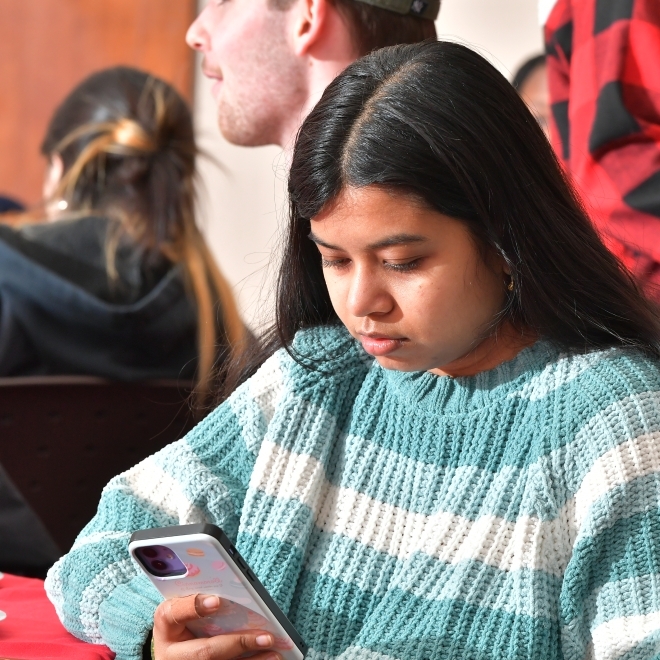Cyberstalking Red Flags You Shouldn’t Ignore

In today’s digital world, social media platforms offer avenues for personal connection. However, along with the benefits come risks, such as technology-facilitated crimes like cyberstalking. Despite the convenience of online interactions, it’s essential to remain on guard against the potential threats posed by anonymity and misuse of digital platforms.
In this blog, you learn about cyberstalking, the red flags, and proactive tips to stay safe online.
What is Cyberstalking?
Stalking is often categorized as someone physically following another person; however, as social media has adapted, so have opportunities for cyberstalking or stalking someone using technology. The St. John’s University SOAR (Sexual Violence Outreach, Awareness, and Response) office offers the following definition of stalking.
“When a person has any level of interaction with another person who causes the first person to have a reasonable fear of safety for themselves or others and cause emotional distress. These behaviors can be committed by anyone, including strangers or someone the victim knows, who uses online methods of intimidation and harassment to catalyze the presence of harmful, physical interaction. Additionally, the vices of intimate partner violence have evolved to using technology for control and stalking methods.”
Four Common Red Flags of Cyberstalking: Protect Your Online Presence
Although many digital platforms are moderated and there have been consistent efforts to prioritize safety, stalking and harassment persist. Many perpetrators find ways to instill fear and use isolation and intimidation tactics over online platforms. Here are several warning signs:
They know personal details about you that you didn’t explicitly share with them.
While it is not very difficult to locate a person’s social media profile, there are people who go beyond looking at surface-level information and may track your current location, where you live, who your family members or closest friends are, where you work or go to school, and more. There can also be instances of invasion of privacy by searching for information about you through your Instagram followers. While your social media content may be publicly accessible, searching for detailed information about you may lead to tracking in the future.
Tip: Be cautious when accepting social media requests. Consider making your profile private or limiting how much content you publicly share. Before posting, think about what information viewers will now have about you and determine your comfort with it.
They pressure you to share locations or track you without your consent.
You might be pressured to share your location and be questioned about your whereabouts. You may exchange Snapchat handles and find the person tracking you using Snap Map, or even showing up unannounced or uninvited to where you are. If you find any unknown apps on your phone or unknown devices in your belongings, it may be a warning sign of stalking. People may even drop an AirTag or “accidentally” leave their AirPods in your belongings to track you.
Tip: Determine whether you are comfortable sharing your location or not. Remember: You can choose not to share with anyone or only with specific people. If someone is pressuring you, that’s a warning sign.
They regulate and micromanage your daily activities presented on social media.
Excessive monitoring of your daily activities is commonly used as a coercive control tactic. This often stems from abusive behavior; the other person wants to remind you that they are always there. They may pressure you into unlocking your phone, sharing your passwords, and monitoring your social media by dictating what you can post/share. Coercive control intends to assert dominance over you and make you feel as if you cannot be trusted on your own. You may often feel trapped when using online media platforms.
Tip: Check in with yourself. If you have a gut feeling that someone’s demands of you seem excessive, you’re probably right. This is an excellent time to set boundaries about your comfort zone.
They threaten to share personal information, sexual content, or private details on social media.
These threats pressure you to comply with demands and silence you and your freedom to use social media and to feel safe. This warning sign is also prevalent within relationships, as abusers can use threats to control their partner. It is never ok for someone to blackmail you.
How to Stay Safe Online: Six Practical Tips
In today’s digital world, safeguarding your online presence is crucial to avoid cyberstalking. The following are some proactive steps you can take.
1. Check Privacy Settings.
Regularly review and adjust the privacy settings on your social media accounts. Limit the visibility of your personal information to only people you know and trust.
2. Be Picky with Friend Requests.
Only accept connections from people you recognize and have met in person. Verify their identity before granting access to your profiles.
3. Guard Your Location.
Avoid sharing your exact location on social media unless necessary. Use location services sparingly to minimize tracking risks.
4. Secure Your Devices.
Protect your devices with strong passwords, two-step authentication, and regular software updates. This prevents unauthorized access to your information.
5. Trust Your Gut.
Follow your instincts if anything online feels suspicious or alarming. Block or report the individual to the platform immediately.
6. Stay Informed.
Learn about the signs and methods of cyberstalking to recognize potential threats early. Keep up-to-date on cybersecurity practices to stay safe online.
Student Resources at St. John’s University
If you are a St. John’s University student experiencing any warning signs, the University offers a variety of resources to help you get the support you need. The Department of Student Health Services and the SOAR (Sexual Violence Outreach, Awareness, and Response) office are committed to providing many strategies to cope with trauma and harm.
If you’d like to speak to someone confidentially about your experience, contact the Campus Support Adviser (CSA) at [email protected] or 718-990-8484 or make an appointment on Medicat. Additionally, SOAR offers training on consent and bystander intervention and provides yearly programming and events on identifying warning signs and creating healthy relationships to foster a safe environment on campus.







